
12 minute read
Volunteers for Veterans
The Center for Development and Civic Engagement (CDCE) builds on a century-and-a-half of service.
By Craig Collins
By the middle of 2020, as the lockdowns and quarantines of the COVID-19 pandemic stretched from weeks to months, the lives of American military Veterans had changed dramatically: Many were literally cut off from the services they relied on to stay healthy and engaged in their communities; tens of thousands found themselves having to learn how to use computers and equipment that would help them teleconference with their health care providers. Appointments through the Veterans Health Administration’s Video Connect program increased more than tenfold, from 10,000 to 120,000 appointments a week.

Maura Campbell, voluntary service specialist at the VA St. Louis Health Care System, received The Beryl Institute’s Volunteer Professionals Award for Excellence for her work implementing VA’s Compassionate Contact Corps.
But the Veterans didn’t have to adapt to these new realities alone. At the Ralph H. Johnson VA Medical Center in Charleston, South Carolina, for example, students launched a “Bridging the Digital Divide” program, in which they helped Veterans with virtual appointments and other technological challenges. The Fisher House Foundation donated computer tablets, so Veterans who couldn’t have visitors in the hospital could still connect with family and friends.
In the months before COVID-19 vaccines were authorized by the U.S. Food and Drug Administration (FDA), a new organization was formed out of an existing phone-buddy program: the Compassionate Contact Corps, a group of volunteers who reached out to Veterans, particularly those in rural areas, who were isolated and starved for social interaction. The social support program, consisting of regular telephone or teleconferencing visits between volunteers and Veterans, was popular, and spread quickly from region to region.
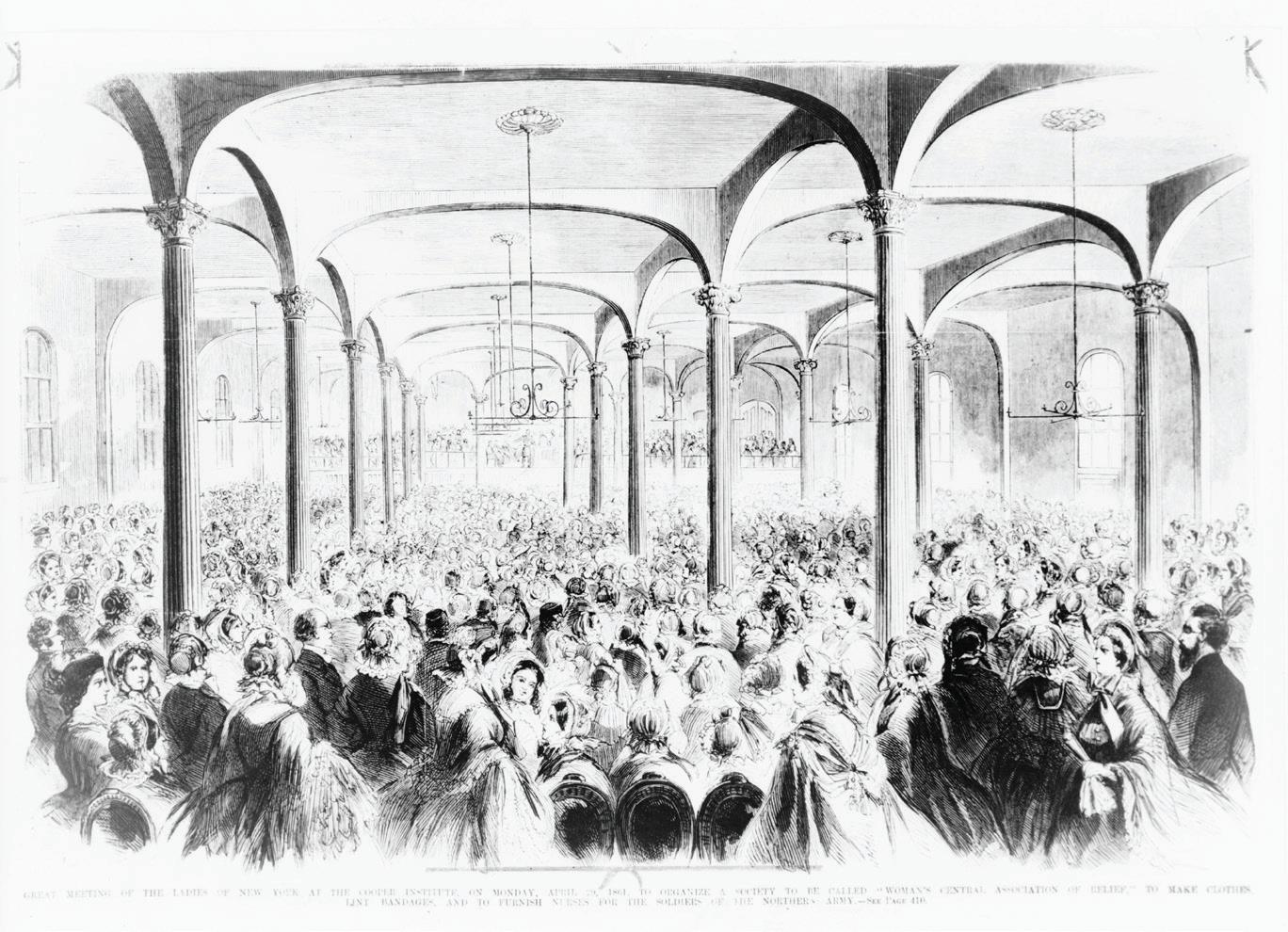
A meeting of the ladies of New York at the Cooper Institute, on April 29, 1861, to organize a society to be called “Women’s Central Association of Relief,” to make clothes and lint bandages, and to furnish nurses for the soldiers of the Union Army.
Senior Corps volunteer support of VA’s Choose Home initiative also proved crucial during the pandemic, as volunteers fanned out across the country to perform tasks – delivering groceries and medicine, or visiting (outside, at a safe distance) – that allowed older Veterans who were at risk of moving into a long-term care facility to remain safe at home.
For the people who delivered these services to Veterans, and every organization, such as the Fisher House, that provided material support, their greatest reward was knowing they’d returned, in some small degree, the favor America’s service members have bestowed in service to their country. It’s a tradition that dates to the Civil War, when volunteers were first organized on a large scale to support service members and Veterans.
EARLY VOLUNTEER ORGANIZATIONS
Not long after the first shots were fired at South Carolina’s Fort Sumter in April 1861, a Women’s Central Association of Relief (WCAR) was established in New York. While one of its first functions was to register nurses for service in military hospitals, the WCAR’s primary purpose was to channel public support for the war effort and organize a volunteer system for procuring supplies on the home front. Women knitted socks, made bandages, prepared food and “comfort bags” that included books, checkerboards, combs, stationery, dominoes, and other items, sat at the bedsides of wounded or sick soldiers, and raised money to purchase medical supplies.
The WCAR’s chairman, Massachusetts clergyman Henry Bellows, realized in a visit to Washington that the group’s efforts needed to be organized nationwide, with a presence in the nation’s capital, to provide advice and assistance to the Union Army regarding medical care and the general welfare. Within weeks of the war’s onset, a larger U.S. Sanitary Commission (USSC) was formed, with Bellows as its president, and was officially endorsed by President Abraham Lincoln. The commission – at the time, the largest national volunteer organization in U.S. history – was created by legislation on June 18, 1861. The WCAR became a supply branch of the USSC.
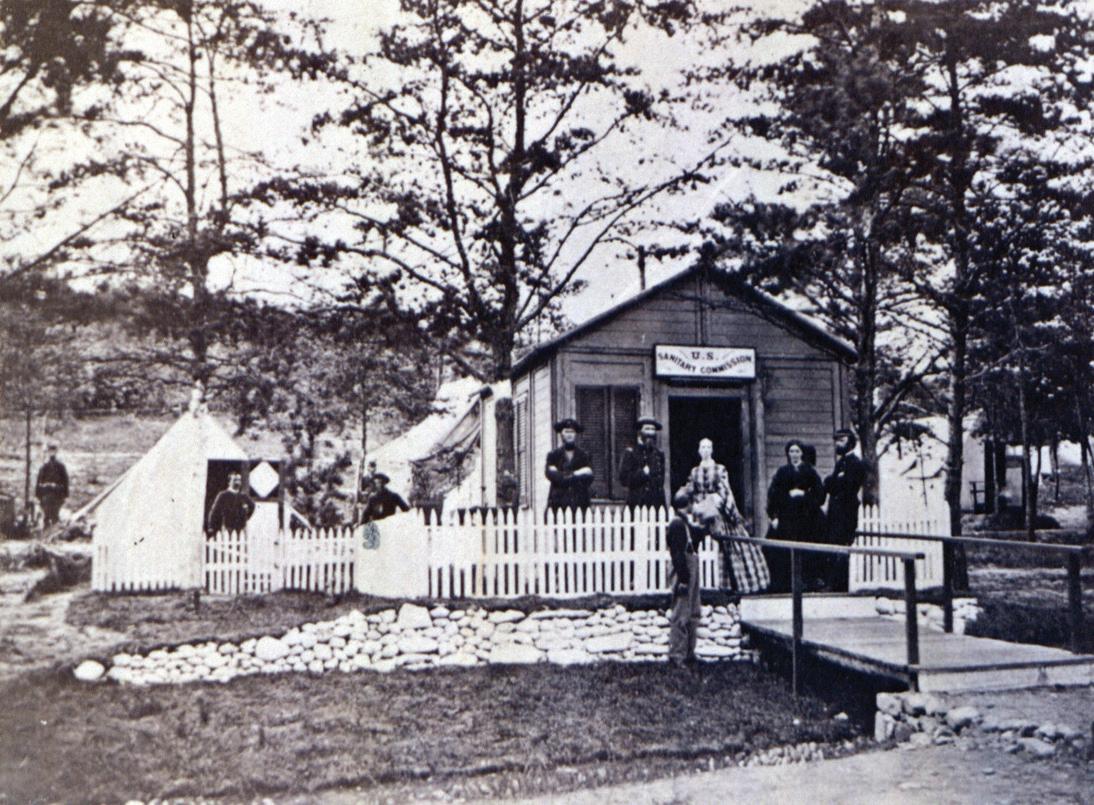
U.S. Sanitary Commission lodge at Convalescent Camp, Alexandria, Virginia, 1863.
Originally formed to “look into the health and sanitary conditions of the Union Army and make recommendations to the government,” the USSC went much further than that in support of warfighters and Veterans. From its headquarters in the U.S. Treasury Building on Pennsylvania Avenue, the commission established local branches in cities throughout the North, where fundraisers were held to buy medical supplies, ambulances, hospital ships, and personal supplies for wounded and recovering soldiers. Throughout the war, USSC volunteers raised an estimated $25 million. Volunteers read to soldiers; recorded the burial locations of those who’d died in battle; corresponded with their families; and much more. The American public was passionate about the war effort, and the legions of volunteers included the poet Walt Whitman, the novelist Louisa May Alcott, and Frederick Law Olmsted, the landscape architect who designed New York’s Central Park.

The Veterans Health Administration did not solicit or approve this content
The U.S. Sanitary Commission also helped to establish the tradition of establishing “soldier’s homes” for Veterans – transitional places where soldiers who were out of medical jeopardy, but who could not return to service, could convalesce. About 60,000 amputations were performed during the war – more than in any other U.S. conflict – and volunteers grew increasingly concerned with how to care for and support men who had lost limbs. In March 1865, just a month before his assassination, Lincoln signed legislation creating a National Asylum of Disabled Volunteer Soldiers, the first federal institution in the world established exclusively to serve disabled Veterans of the volunteer forces. The board that chose the site described the facility as “a home, where subsistence, quarters, clothing, religious instruction, employment when possible, and amusements are provided by the government of the United States. The provision is not a charity, but is a reward to the brave and deserving.” A few years later, its name was changed to the National Home for Disabled Volunteer Soldiers, and by 1929, there were 11 branch facilities throughout the country.
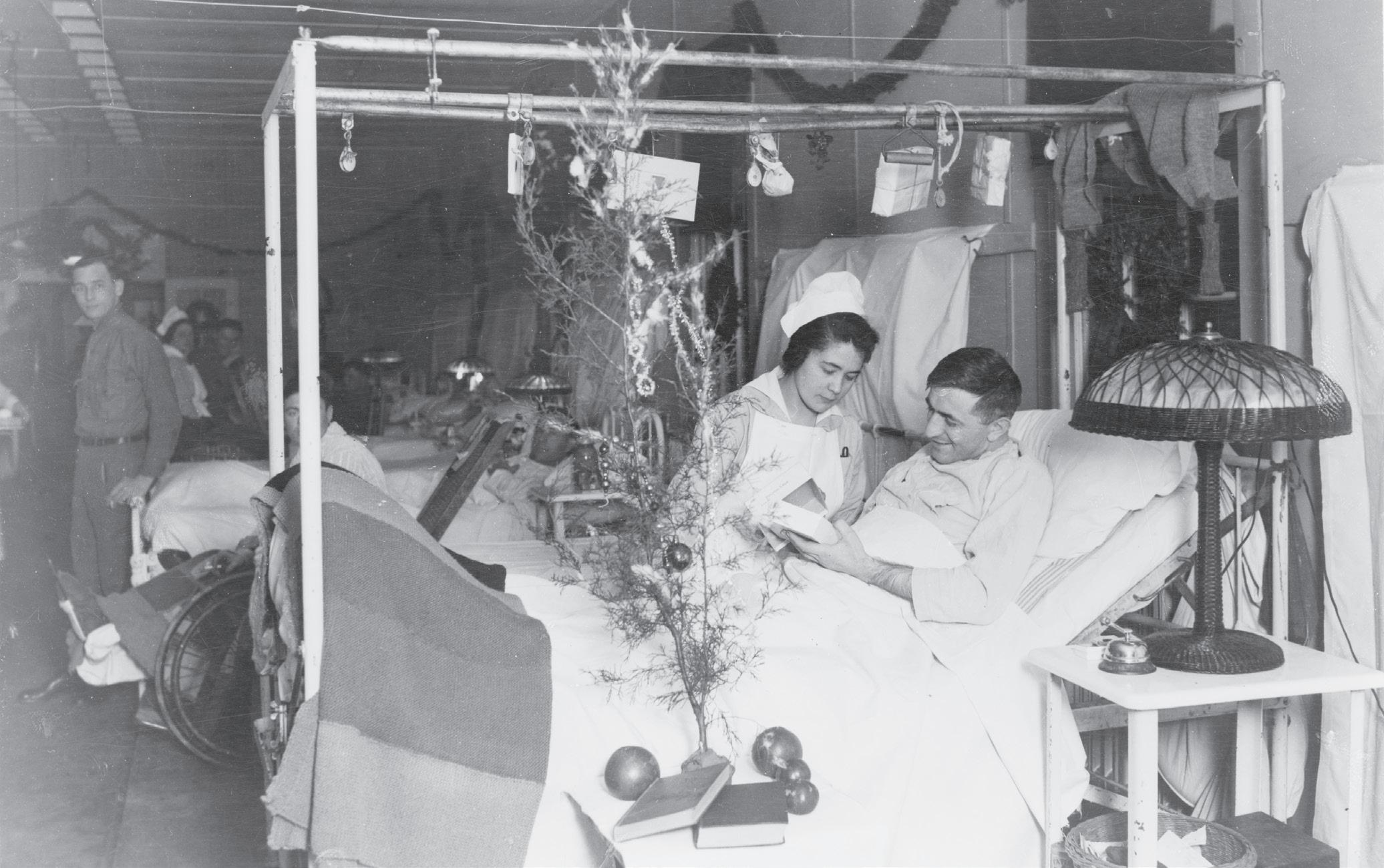
A Red Cross nurse cares for a wounded soldier during the holiday season in World War I.
Because the U.S. Sanitary Commission disbanded after the war, volunteer support for Veterans was virtually nonexistent for a time. The National Homes were relatively self-sufficient for the rest of the 19th century, and Veterans’ needs were met by a Post Fund, established in the National Homes’ founding legislation, that could raise money and accept donations.
When American service members began fighting the next big war, World War I, medical care and other benefits were provided to Veterans by the Treasury Department, through its Bureau of War Risk Insurance and the new Public Health Service. The work of these agencies was supplemented by volunteers from the American Red Cross, the nonprofit humanitarian organization founded by Clara Barton in 1881.
The Red Cross’ auxiliary workforce performed many tasks, including clerical work, laboratory assistance, social work, and nursing. Because the Public Health Service was limited, by law, to providing for the medical needs of soldiers and Veterans, Red Cross volunteers were encouraged by the surgeon general to provide for other needs: offering reading materials and other entertainments, sometimes live shows or concerts; taking Veterans on automobile rides; providing comforts such as pajamas and socks; and generally working to boost the morale of patients at the Public Health Service’s Veterans’ hospitals.
The consolidation of these efforts to provide medical and other benefits to Veterans began after the war, with many Red Cross functions being taken on by the federal government – often by former volunteers who signed on as employees in the agency that would become, in 1930, the Veterans Administration (VA).
THE VA VOLUNTARY SERVICE (VAVS)
Volunteer organizations once again stepped up to come to the aid of service members and Veterans as the United States began to mobilize for war in 1941. In June 1945, after Germany’s surrender, President Harry Truman appointed Army Gen. Omar Bradley, who’d commanded three corps of soldiers during Operation Overlord, the invasion of Normandy, to lead the VA. In choosing Bradley, a fellow Missourian, Truman signaled he wanted a leader who would, while maintaining the agency’s commitment to World War I Veterans, have insight into the needs and interests of a new generation of Veterans. Bradley implemented a sweeping overhaul of the administration, establishing several programs modeled after successful War Department programs. One of his first reforms was the establishment of a Special Services division within VA to support the morale and social well-being of Veterans, particularly those among the more than 670,000 service members who had been wounded in World War II.

The Veterans Health Administration did not solicit or approve this content
The new Special Services division, led by Army Col. Francis Kerr, was organized under the new Medical and Surgery Department, and administered four major services: canteen, chaplaincy, recreation, and library. In May 1946, a National Advisory Committee was established to coordinate and integrate the supplemental assistance of volunteer organizations within Special Services, a program defined and established as the VA Voluntary Service (VAVS). The eight organizations comprising this first committee – the American Legion and its Auxiliary, the American National Red Cross, Disabled American Veterans (DAV) and its Auxiliary, United Service Organizations (USO), and Veterans of Foreign Wars (VFW) and its Auxiliary – are now among more than 50 that coordinate the efforts of a vast network of volunteers and partners.
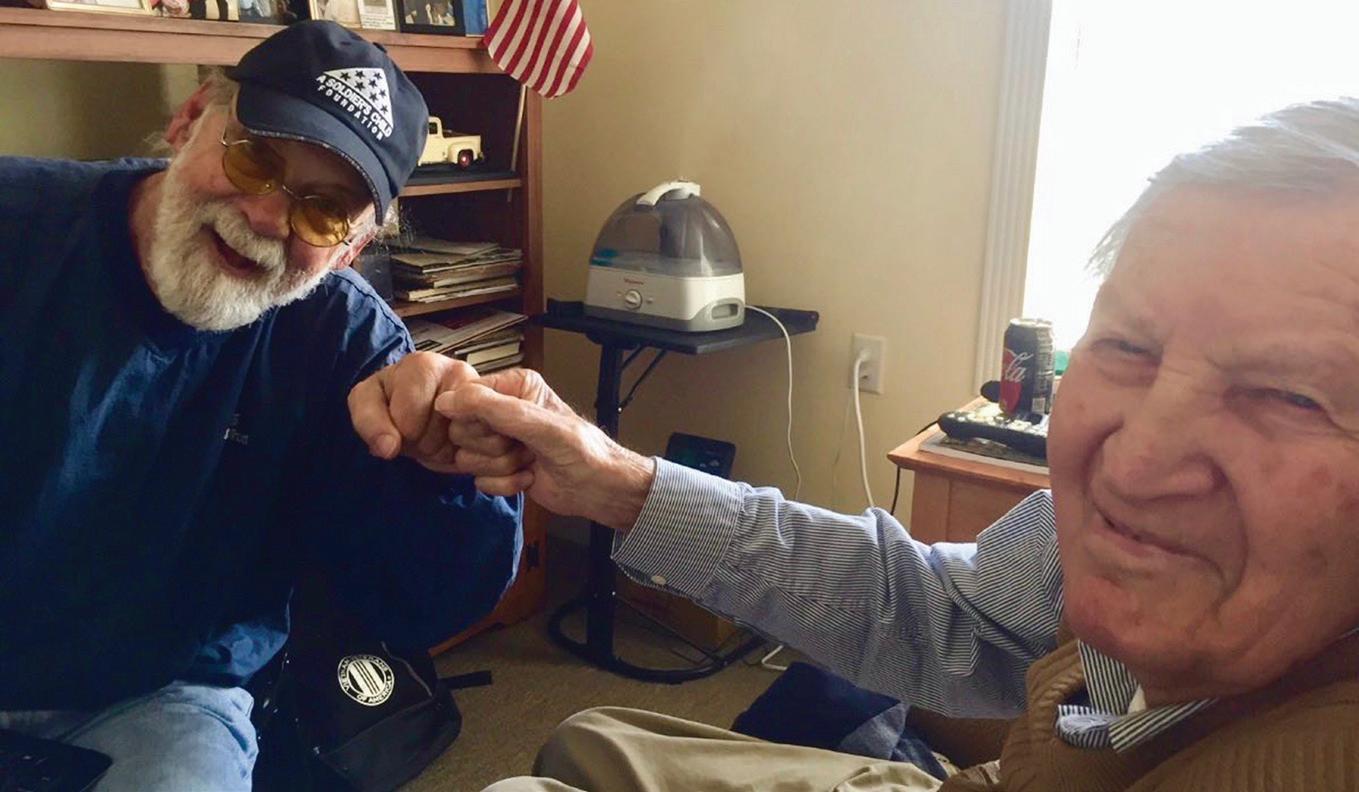
Operation Song connects Veterans telling their stories with professional singer-songwriters who record them as songs.
James H. Parke, a Veteran of the Army’s Special Services, was tapped to lead VAVS, which he directed for nearly a quarter-century before his death in 1970. Charlotte von der Heyde, who had served as a Navy lieutenant in World War II, was appointed to serve as the liaison between VAVS and the national voluntary service organizations.
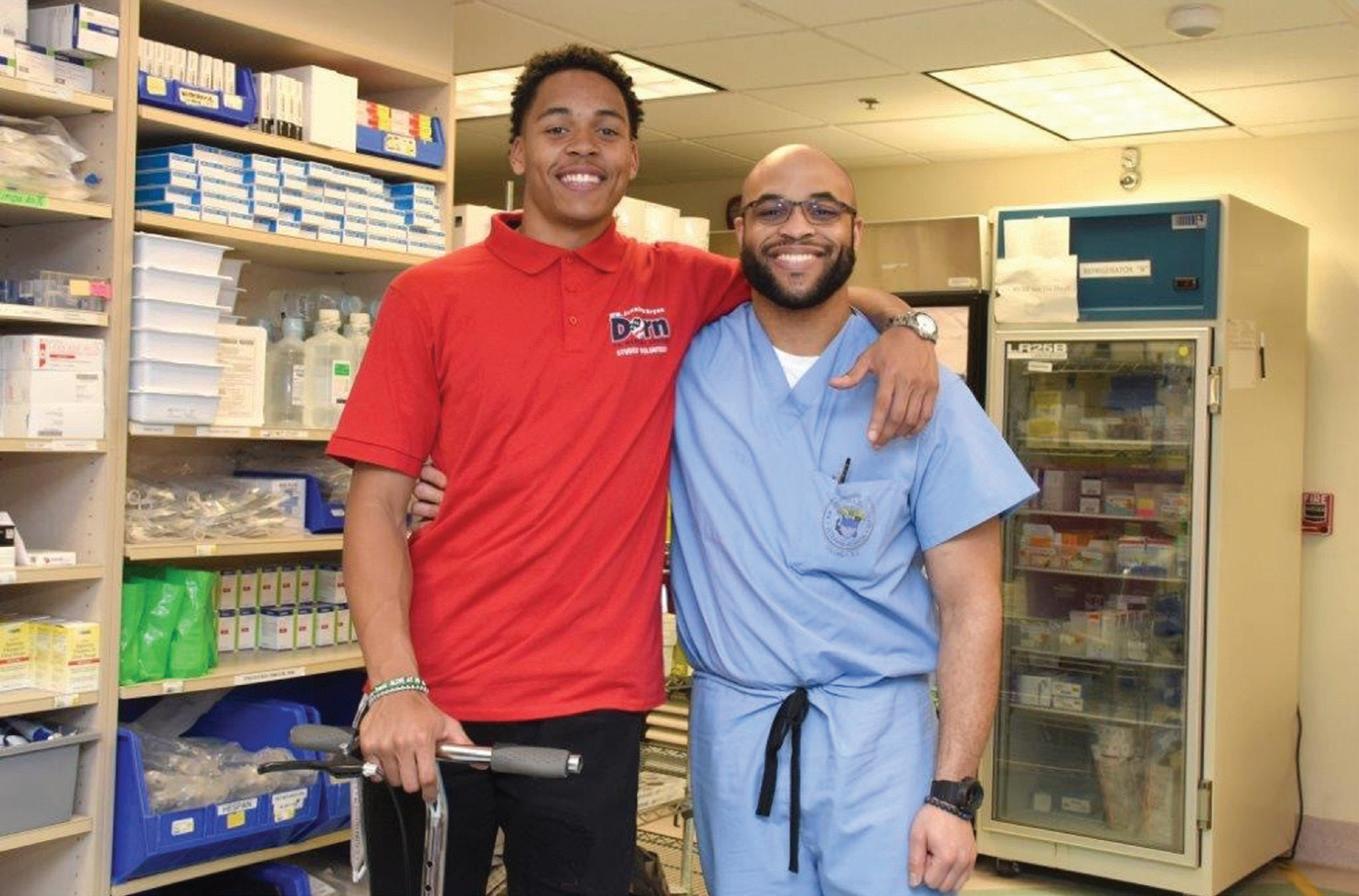
$20,000 James H. Parke Memorial Fund Youth Scholarship Award winner Daniel Finney (left) volunteered his summers to serve Veterans.
In the ensuing decades, VA’s volunteer program, administered by a professional staff at a national office, grew into one of the largest and most accomplished corps of volunteers in the federal government: By 1974, when most of the 2.7 million American men and women who served in Vietnam had returned home, the number of volunteer hours contributed through the program exceeded 10 million. By the time the VA was elevated to cabinet-level status – as the Department of Veterans Affairs, established in 1988 – VA volunteers were being placed in more than 150 different assignment categories and serving in a variety of settings, including VA readjustment counseling centers, community service centers, and contract nursing and residential care homes.
TODAY’S CDCE: FROM “NICE” TO “NECESSARY”
In the spring of 2021, VHA’s 75th year of existence, the number of hours contributed by VA volunteers surpassed 1 billion. That number, astonishing as it is, does not capture the scope of the effort that has evolved to serve the needs of Veterans and their families. By the end of one of the most transformative years of the service’s existence, it had become clear that the name of the service itself didn’t capture it, either: In December 2020, after 74 years of being known as the VA Voluntary Service, the organization changed its name to the Center for Development and Civic Engagement (CDCE).
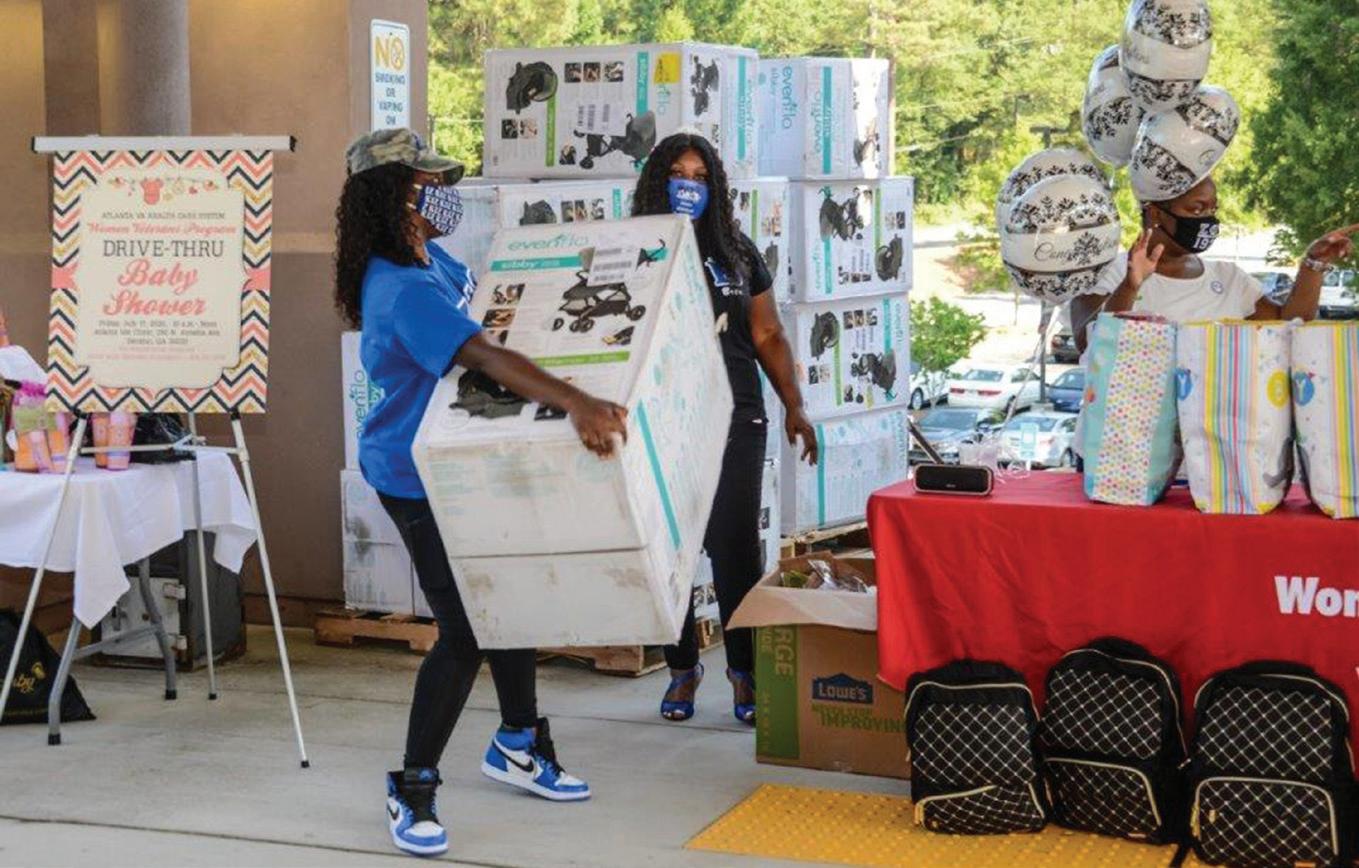
Volunteers from Zeta Phi Beta Sorority, Inc., lend assistance for a Drive-Through Baby Shower at the Atlanta VAMC.
In a conversation with VHA Historian Katie Delacenserie and producer Shawn Spitler during an episode of VA’s Standing Ready podcast, CDCE Director Sabrina Clark, PhD, explained that for decades, the VA Voluntary Service had been known primarily as the coordinating hub for volunteer activities that served Veterans and their families. “We got locked into an identity,” Clark said, “about being only about volunteers. And what went missing was the donations, the philanthropic activity, the partnership activity, and all the things we do with corporations and nonprofits. That piece of the work – the development piece, about forging relationships – these things were always critical to who we were, but our name didn’t really reflect that.”
At its core, the CDCE remains unchanged; it works through several established programs, including:
• the Student Volunteer Program, which provides VA medical center treatment teams with valuable liaisons. The James H. Parke Memorial Youth Scholarship, established to honor the service’s founding father, provides opportunities to student volunteers to further develop their skills and contribute to the well-being of Veterans.
• the National Salute to Veteran Patients, which began in the 1970s, is a weeklong expression of appreciation –by Veterans groups, military personnel, civic organizations, businesses, schools, local media, celebrities, sports stars, and other individuals –for the more than 9 million Veterans cared for at VA facilities throughout the country.
• the Volunteer Transportation Network, established by Disabled American Veterans in 1987, which provides transportation to Veterans receiving services at VA or authorized facilities.
• the Physician Ambassador Program, created in 2017, which recruits and places fully licensed volunteer physicians and clinicians to serve, without compensation, in a health care team at a VA medical facility.
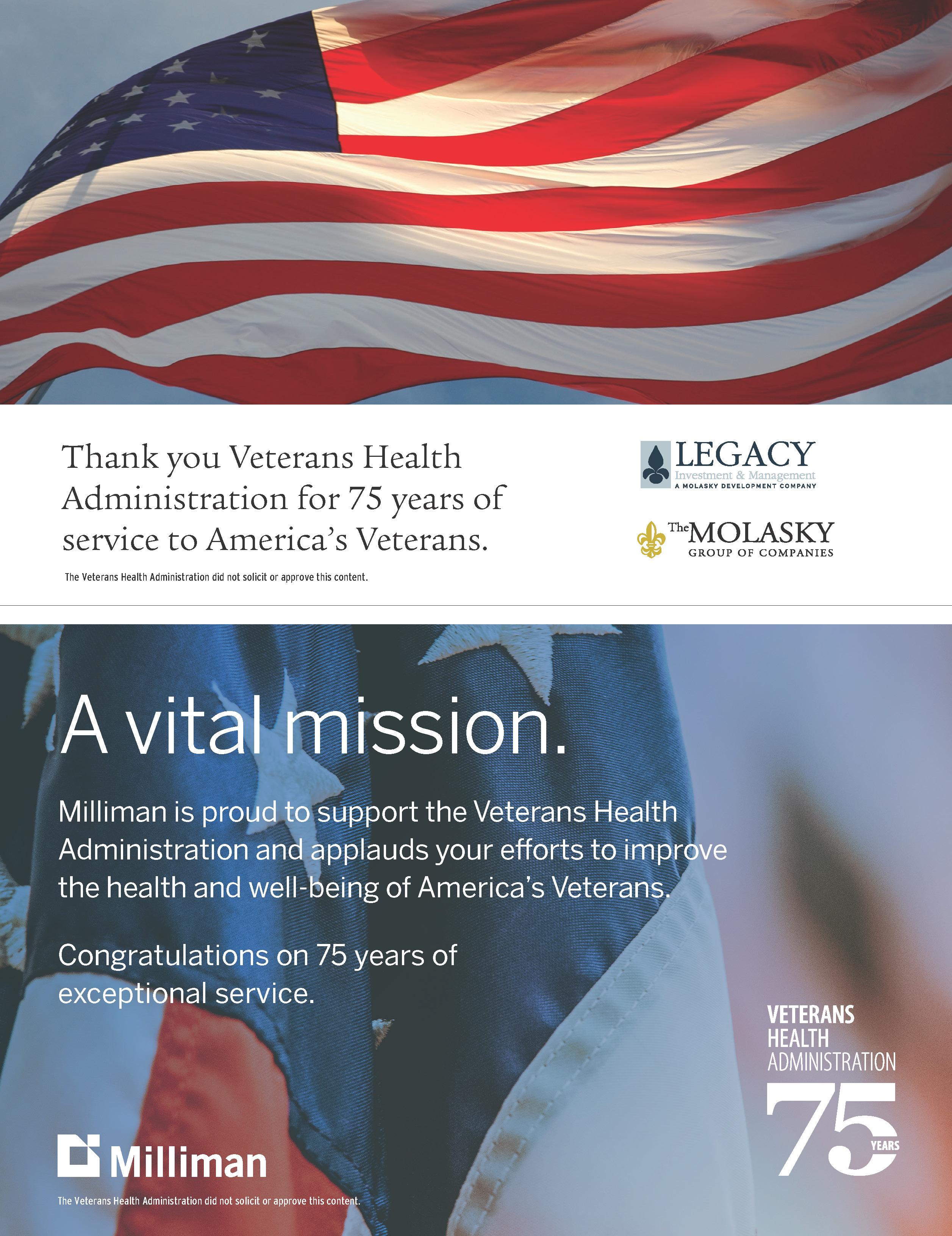
The Veterans Health Administration did not solicit or approve this content
Corporate volunteerism has become part of these core capabilities in recent years, as company-sponsored volunteer programs allow employees to put their specialized skills to work for Veterans. Employees of Home Depot, for example, have installed donated ornamental plants to spruce up the entrance of a VA facility –and the company also operates a grant program to help fund the development and repair of Veteran housing. Along with the Physician Ambassador Program, which elicits contributions from highly skilled professional volunteers, these initiatives exemplify what Clark describes as a movement from volunteers providing merely “nice” services – reading to Veterans, showing appreciation, or otherwise boosting morale – to include more “necessary” services, such as making sure Veterans complete their scheduled medical appointments.
The Compassionate Contact Corps, led by Navy Veteran and CDCE Deputy Director Prince Taylor, has expanded to be administered from more than 80 sites throughout the VA health care system, where volunteers and VA professionals – without a mandate or funding from Congress and without a top-down directive from the secretary or under secretary – have decided that reaching out to isolated Veterans is an important thing to do, and have organized a social support network that reaches as many as possible.

About 69 Home Depot and Tampa Police Department volunteers help improve the grounds around the James A. Haley Veterans’ Hospital Spinal Cord Injury Center June 2, 2017.
As the nation emerges from the pandemic, it’s clear that the CDCE, like so many institutions, has been transformed – permanently, in ways that are just now becoming apparent. These changes are welcome to Clark, who has been overwhelmed by the variety of volunteers and partners who have leapt to the aid of Veterans. The future of the CDCE, she said, will continue the trend she’s seen in her time as director: “The diversity of people and organizations we will bring in … There will be organizations that never thought there was a place for them in VA … being flexible and adaptable in this time is bliss, because it just keeps us growing and responsive to what Veterans need.”










